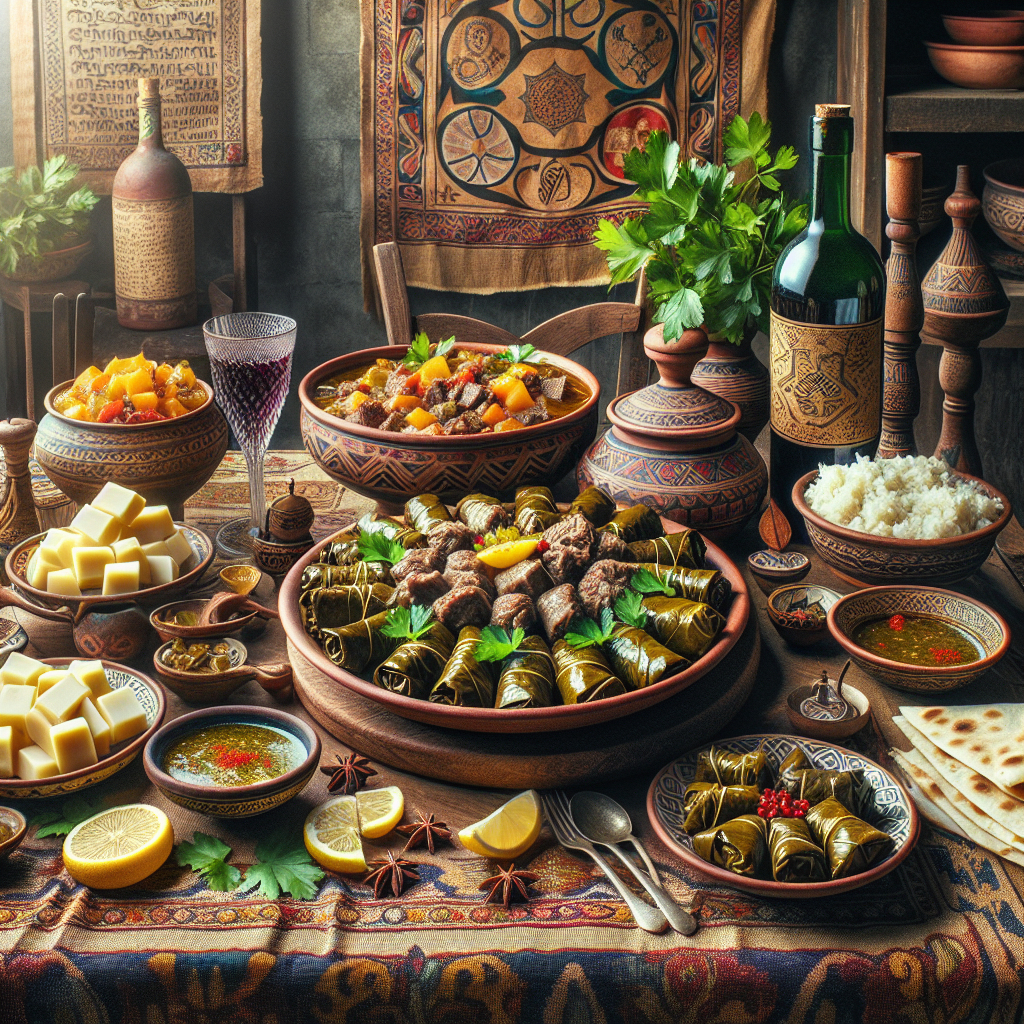Welcome to Ararat’s Ancient Flavors, a vibrant exploration into the rich tapestry of Armenian cuisine. Known far and wide for its hearty, flavorful dishes and deep culinary traditions, Armenian cuisine is a hidden gem within the global gastronomy scene. This blog invites you to journey through the age-old recipes, unique ingredients, and food customs deeply woven into Armenia’s cultural fabric.
At Ararat’s Ancient Flavors, we believe that every dish tells a story, and it’s our mission to share these narratives with you. From the sun-soaked fields of the Ararat Valley, to the bustling kitchens of Yerevan, we’ll uncover the secrets of Armenian cuisine, one recipe at a time. Whether you’re a seasoned foodie or a curious novice, we invite you to explore, discover, and taste the diversity of Armenian cuisine with Ararat’s Ancient Flavors.
Origins of Ararat’s Ancient Flavors
The historical origins of Ararat’s Ancient Flavors can be traced back to the early Bronze Age, making it one of the most ancient culinary traditions in the world. Located in the South Caucasus, the Ararat region developed a unique culinary culture influenced by the indigenous Armenian people, the geographical location, and interactions with neighboring cultures. Ararat’s Ancient Flavors are deeply rooted in the agricultural richness of the region, with a focus on fresh, seasonal, and locally sourced ingredients.
Development of Ararat’s Ancient Flavors
The development of Ararat’s Ancient Flavors is synonymous with the evolution of Armenian civilization. The cuisine evolved over thousands of years, incorporating the influences of various historical epochs. The adoption of Christianity in Armenia in 301 AD brought religious dietary regulations, which further shaped the cuisine. The Armenian Diaspora, which spread Armenian people and culture worldwide, also contributed to the diversity of Ararat’s Ancient Flavors.
The Role of Trade and Migration
Trade along the Silk Road brought new ingredients and cooking techniques to Armenia, enriching Ararat’s Ancient Flavors. Likewise, migration and the Armenian diaspora played a significant role in introducing Armenian cuisine, including dishes from Ararat, to the world.
Significance in Armenian Cuisine
Ararat’s Ancient Flavors holds a prominent place in Armenian cuisine, representing the country’s rich history and culinary traditions. The cuisine is characterized by a variety of flavors, using unique ingredients such as pomegranates, apricots, and lavash bread, which have become symbols of Armenian food culture. Moreover, the method of cooking, often slow and meticulous, reflects the Armenian reverence for food as a central part of their culture and hospitality.
Preservation of Culinary Heritage
Preserving and promoting Ararat’s Ancient Flavors is of immense importance to Armenians. Traditional recipes are passed down through generations, and many Armenians continue to cultivate and use ancient grains and varieties of fruits and vegetables, thus safeguarding their unique culinary heritage.
Global Recognition
Ararat’s Ancient Flavors have gained global recognition, with Armenian cuisine named as one of the top food trends in recent years. The unique combination of flavors, the use of fresh, natural ingredients, and the deep cultural significance of the dishes have made Ararat’s Ancient Flavors a culinary treasure both in Armenia and around the world.
Ararat’s Ancient Flavors: A Journey into Armenian Culinary Traditions
Armenia, a country with an ancient cultural heritage, has a rich and diverse cuisine, characterized by a variety of unique ingredients. Ararat’s ancient flavors are based on these traditional foods and cooking methods, offering a true taste of Armenia’s rich culinary history.
Local Spices
One of the key elements that make Ararat’s ancient flavors so distinctive is the use of local spices. Armenian cuisine is renowned for its rich, complex flavor profiles, achieved by blending a variety of spices. Two of the most commonly used spices in Armenian cooking are red and black pepper. Other spices include coriander, fenugreek, and cinnamon.
A particularly unique spice blend is “Basturma” – a mixture of fenugreek, garlic, and chili, used to cure meat. This spice blend gives the meat a distinctive, robust flavor that is characteristic of Armenian cuisine.
Traditional Cooking Methods
Armenian culinary traditions also center around specific cooking methods. One such method is the use of the “tonir,” an underground clay oven. This oven is used to bake bread and cook a variety of dishes, giving them a unique, earthy flavor.
Another traditional cooking method is the use of a “khorovats,” or barbecue. Meat, often marinated in a mixture of Armenian brandy, onions, and spices, is skewered and then grilled over an open fire. This traditional cooking method gives the meat a smoky, rich flavor that is a hallmark of Ararat’s ancient flavors.
Unique Ingredients
Armenian cuisine also makes use of a variety of unique ingredients. One such ingredient is “khorovats,” a type of Armenian cheese. This cheese is often used in a variety of dishes, from salads to pastries, giving them a distinctive, tangy flavor.
Another unique ingredient is “dried lavash,” a type of Armenian flatbread. This bread is often used in a variety of dishes, from wraps to casseroles, providing a unique texture and flavor.
The Taste of Ararat’s Ancient Flavors
The unique ingredients, local spices, and traditional cooking methods used in Armenian cuisine all contribute to the distinctive taste of Ararat’s ancient flavors. These flavors are a testament to Armenia’s rich culinary history, offering a real taste of this country’s diverse and delicious cuisine. Whether you’re an adventurous foodie or a lover of traditional dishes, Ararat’s ancient flavors offer a culinary journey unlike any other.

Ararat’s Ancient Flavors are more than just a palate-pleasing array of tastes – they are a testament to Armenia’s rich history, cultural heritage, and the resilient spirit of its people. The local cuisine, deeply rooted in centuries-old culinary traditions, is characterized by unique ingredients that are as diverse as the stunning landscapes of Armenia itself.
From the majestic peaks of the Mount Aragats Summit to the lush wilderness of the Dilijan National Park, and the spiritual tranquility of the Khor Virap Monastery, every corner of Armenia contributes to its gastronomic identity.
Ararat’s Ancient Flavors play a crucial role in Armenian culture, serving as a bridge that connects the past with the present, and the local with the global. They are a symbol of Armenian hospitality, a celebration of its agricultural abundance, and a reflection of the country’s geographical and cultural diversity.
For a deeper exploration of Ararat’s Ancient Flavors, consider visiting authoritative sources like Food Network Ararat’s Ancient Flavors or Bon Appétit Ararat’s Ancient Flavors. These platforms offer a wealth of information on Armenian cuisine, from traditional recipes and cooking techniques to modern interpretations and food stories from across the country.
In conclusion, Ararat’s Ancient Flavors are not just a culinary tradition, but a treasured piece of Armenia’s cultural fabric. They tell stories of the land, the people, and their history, offering a taste of Armenia that is as memorable as it is delicious. It is a gastronomic journey that is deeply intertwined with the country’s natural beauty, historical landmarks, and the warm hospitality of its people.


Comments
One response to “Ararat’s Ancient Flavors”
This article focusing on Ararat’s Ancient Flavors. It’s truly captivating to learn about how the geographical location and historical events have shaped and enriched the local cuisine over time. I was particularly intrigued by the use of unique ingredients and traditional cooking methods, such as the “tonir” and “khorovats,” which undoubtedly contribute to the distinctive taste of Armenian dishes.
The commitment to preserving this culinary heritage is truly commendable. The fact that these traditions are passed down through generations, with a focus on using fresh, local ingredients, not only helps to maintain the authenticity of the dishes but also supports local agriculture and promotes sustainability.